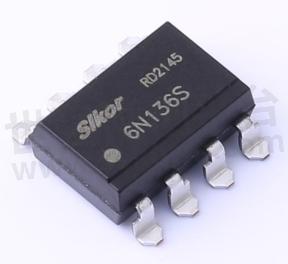An Optocoupler Enables Safe Signal Transmission While Ensuring Electrical Isolation




In the world of consumer electronics, the optocoupler is an essential component that plays a pivotal role in isolating and protecting sensitive circuits. But what exactly is an optocoupler and how does it function? This article explores the fundamentals, history, characteristics, and applications of optocouplers in modern electronics.

SLKOR 6N136S Optocoupler | Alternative equivalent for Onsemi 6N136SDM
What Is an Optocoupler?
An optocoupler, also known as an optoisolator, is a crucial electronic component used to transfer electrical signals between two isolated circuits. This is done by using light to bridge the gap between the input and output without direct electrical contact. The optocoupler typically consists of an LED (light-emitting diode) and a photodetector such as a photodiode or phototransistor.
In simple terms, an optocoupler enables safe signal transmission while ensuring electrical isolation, which protects sensitive components from voltage spikes, noise, or other interference.
The Development History of Optocoupler
The first optocoupler was developed in the 1960s, driven by the need to improve circuit isolation in various electronic systems. As electronics became more complex, the need for reliable isolation between low-voltage and high-voltage circuits grew. Early versions of optocouplers were primarily used in telecommunication and power supplies. Over time, their use expanded into areas like automotive electronics, medical devices, and industrial controls.
As technology advanced, so did the performance of optocouplers, with improvements in efficiency, speed, and the ability to handle higher power levels. Today, they are integral to modern electronic design, helping manage everything from microcontroller interfacing to power management systems.
Characteristics of Optocoupler
Understanding the characteristics of optocouplers is crucial for selecting the right type for your application. Some key features of optocouplers include:
Electrical Isolation: Provides galvanic isolation, preventing high voltages from damaging sensitive components.
Speed: Depending on the type, optocouplers can operate at high speeds, making them suitable for high-frequency applications.
Low Power Consumption: Many modern optocouplers are designed to be power-efficient, helping reduce overall system energy consumption.
Reliability: Optocouplers are highly reliable and durable in harsh environments, making them ideal for industrial and automotive applications.
The efficiency of an optocoupler depends on several factors, such as the type of photodetector used, the input-output isolation voltage, and the response time.
Parameters of Optocoupler
When selecting an optocoupler for a specific application, several parameters must be considered:
Input Voltage: The voltage that the LED inside the optocoupler will receive.
Output Current: The current at the output side, which is determined by the photodetector's response to the LED signal.
Isolation Voltage: The maximum voltage difference between the input and output terminals that the optocoupler can withstand without breakdown.
Transfer Ratio: Indicates how well the LED signal is transferred to the output side. A higher transfer ratio means better signal integrity.
Roles of Optocoupler in Electronics
The optocoupler serves several critical roles in modern electronic systems:
Signal Isolation: Protects sensitive components by isolating high-voltage signals from low-voltage circuits.
Noise Reduction: Helps eliminate electrical noise and spikes, which can affect signal quality and system performance.
Data Transfer: Facilitates the safe transfer of data between isolated circuits, often in digital systems.
Switching and Control: Acts as a switch in various control systems, particularly in power supplies and motor drivers.
Applications of Optocoupler
Optocouplers are widely used in various applications due to their versatility and reliability. Some common areas of use include:
Power Supplies: In isolated power supplies to protect low-voltage circuits from high-voltage spikes.
Microcontroller Interfacing: Used to connect microcontrollers to high-voltage devices without compromising safety.
Automotive Electronics: In car electronics for isolating sensor and actuator signals.
Signal Processing: Used in communications equipment to maintain signal integrity while isolating the input and output circuits.
Industrial Systems: Essential in industrial control systems to manage signal isolation between control systems and heavy machinery.
Conclusion
Understanding the functionality and applications of optocouplers is essential for engineers and procurement teams working in consumer electronics. These components offer critical advantages, such as electrical isolation, noise reduction, and protection for sensitive components. By selecting the right optocoupler based on key parameters such as isolation voltage, transfer ratio, and speed, engineers can ensure optimal performance and safety in their designs. As technology continues to evolve, optocouplers will remain integral to a wide range of modern electronic systems.
- +1 Like
- Add to Favorites
This document is provided by Sekorm Platform for VIP exclusive service. The copyright is owned by Sekorm. Without authorization, any medias, websites or individual are not allowed to reprint. When authorizing the reprint, the link of www.sekorm.com must be indicated.
Recommend
Has SLKOR Passed ISO14001?
2024-08-31 - Technical Discussion SLKOR has obtained ISO9001, SGS, ROHS, REACH, and California Proposition 65 certifications. ISO14001 certification is currently in the planning phase for implementation.
Applications of Press-Fit Connectors in Automotive Electronics
2025-07-11 - Technical Discussion Press-fit connectors are widely used in automotive electronics due to their reliable, solderless connection method, which is crucial for meeting the stringent quality and safety standards of the automotive industry.
Slkor P6SMB27A Transient Voltage Suppression Diode and Yangjie Technology Provincial Key Laboratory
2025-05-10 - Technical Discussion The P6SMB27A transient voltage suppression diode from Slkor, with a reverse working voltage of 27V, provides a stable reverse voltage withstand capability for circuits. Its breakdown voltage range is between 25.7V and 28.4V, it has a reverse leakage current of only 1mA, excels in applications that require high precision and low power consumption.
SLKOR Optocoupler SL-1009 with a High Insulation Voltage of up to 5000Vrms is Widely Used in Electronic Systems
2024-01-04 - Product Introduction SL-1009 is applicable in many fields. In programmable controllers, it can be used for optoelectronic isolation between input and output modules to achieve signal isolation and transmission. In system equipment, it can be used to isolate control signals, avoiding interference and damage. In telecommunications equipment, it can be used for signal transmission and isolation between fiber optic communication and network devices. In household appliances, it can be used in control circuits for devices such as fans and heaters, enabling safe and reliable operation.
Slkor Optocoupler SLH11L1: A High-performance, Highly Reliable Optocoupler Solution
2023-09-08 - New Product Introduction The SlkorMicro optocoupler SLH11L1 is a high-performance and highly reliable optocoupler solution. It exhibits significant parameter advantages with a VCEO (Voltage Collector-Emitter) of 16V, IC (Collector Current) of 50mA, VR (Reverse Voltage) of 6V, IF (Forward Current) of 60mA, and a DIP-6 package.
SLKOR Optocoupler SL3053: The Best Choice for Stable Isolation Function
2024-01-05 - Product Introduction The optocoupler SL3053, as a high-performance optocoupler, utilizes an AIGaAs infrared emitting diode as the transmitter. It optically couples with a single silicon random phase optically-controlled silicon bilateral switch component housed in a plastic DIP6 package with different lead forming options, providing the most stable isolation function.
SLKOR‘s Optocoupler 6N136 Provides a High Level of Isolation up to 5000VRMS and Comes in a DIP-8 Package
2024-01-06 - Product Introduction Optocoupler, also known as opto-isolator, is an electronic component that can isolate and transmit signals between light and electrical signals. It consists of a light-emitting diode (LED) and a phototransistor, which are used to isolate input signals and transmit them to the output through light. Today, we will introduce SLKOR Semiconductor‘s product - Optocoupler 6N136.
Reed Relays & Optocouplers PRODUCT LINE BROCHURE
2024/6/21 - Supplier and Product Introduction
HI,HM,BT00-2A00,SIL00-0X00-00XHR,CRF00-1AX-(250),HF00-1A-54-0,SPL,MHV00-1A,H00-1X00,SIL RF,MHV,SHV,NP-CL,HM00-1X00-000,DIL-CL1A00-0000-000,MS,HI00-1A00,DIL00-0X00-00X,MRX00-0X00,KT00-1A-40X-XXX,MS00-1A87-75XXX,521,522,CRF,567,SIL,DIP00-0X00-00XHR,525,UMS,528,DIL-CL,BTS,MRE,CRR,BE,SIL00-1X00-00XXX,BTS00-2A00,MRX,BT,530,535,NP-CL1A00-0000-000,DIP00-0X00-00X,BE00-0X00-X,SHV00-1A85-78X0K,DIL,KT,DIP,UMS05-1A80-75XXX,LI00-1A00,RM05-8A-SP,HE00-0X00-000,MRE00-0X00-X,CRR00-1AX-(250),LI,HE,HF,SIL00-1A72-74X
查看更多版本SLKOR Optocoupler SLM501: Characterized by High Isolation Voltage Reaching 3750VRMS
2024-01-03 - Product Introduction SLM501 is a product that possesses multiple outstanding features and parameters. Firstly, it has high isolation voltage, reaching 3750 VRMS. This means that it can effectively isolate input and output signals during the optoelectronic conversion process, ensuring system reliability and stability. Secondly, SLM501 features high-speed transistor DC input.
Chargers for consumer electronics (10 to 240 W)
0923 - Solutions
P6SMB,SMBJ,SPHV24,SETP0805-100-CC,373,1.5SMB,LS SERIES,CPC1301,435,218,MBR,SP3522,DST,P6KE,SMCJ,443E,SMF,0402SFF,SMF4L,TE,438GT,LA,8.0SMDJ,TR,DXX15L
SLKOR Optocoupler 6N135S with High Isolation Performance of up to 5000VRMS and Transmitter Current (IF) of 25mA
2024-01-10 - Product Introduction The 6N135S is a high-performance optocoupler that can be used in a variety of applications. Whether it is in-line receivers, telecommunications equipment, CMOS-LSTTL-TTL output interfaces, broadband analog couplings, pulse transformer replacements, or computer peripheral interfaces, the 6N135S provides efficient and reliable signal transmission support.
SLKOR Develops PC817C Optocoupler with an Input-output Isolation Voltage of 5000Vrms
2023-08-22 - New Product Introduction PC817X is a photoelectric coupler product composed by a luminous diode and a photo transistor, with the input-output isolation voltage of 5000Vrms and the typical value of the response time tr of 4 μs.The minimum CTR is 80%the at 2mA input current. SOP4 package is adopted for the product.
What Are the Hot-Selling PN of SLKOR? Including S8050, TL431, SS8550 And Others
2024-08-27 - Product Introduction The hot-selling PN include S8050, TL431, SS8550, FR107, LM321, ZMM5V6, SMBJ12CA, B5819WS, Schottky diode B5819WS, PC817C, optocoupler PC817C, voltage regulator AMS1117-3.3, etc. More hot-selling PN of SLKOR can be checked on www.szlcsc.com.
Slkor Brand Optocoupler SL3063 with A Isolation Voltage of 5kV Addressing the Problem of Inadequate Electrical Isolation
2023-09-06 - Product Introduction The SlkorMicro SL3063 bidirectional triac output optocoupler has a forward voltage drop of 1.24V, forward current of 60mA, off-state peak voltage of 600V, static dv/dt of 1000V/μs, isolation voltage of 5kV, and operates within a temperature range of -40℃ to +100℃.
Electronic Mall
 Auth. Dist.
Auth. Dist.
 Auth. Dist.
Auth. Dist.
Integrated Circuits
Discrete Components
Connectors & Structural Components
Assembly UnitModules & Accessories
Power Supplies & Power Modules
Electronic Materials
Instrumentation & Test Kit
Electrical Tools & Materials
Mechatronics
Processing & Customization


























































































































































































































































































































































































































































































































































































































































































































































































































































































































































































